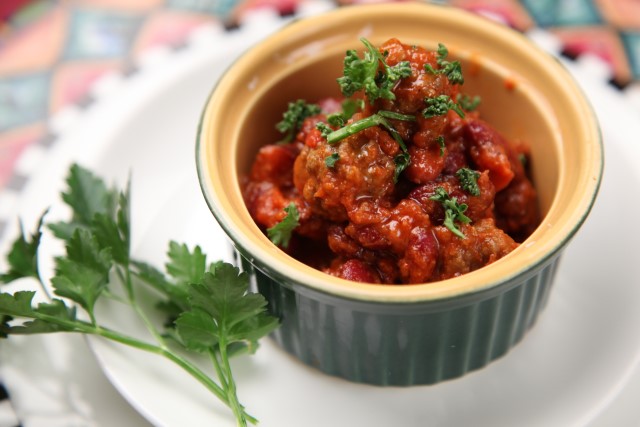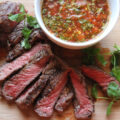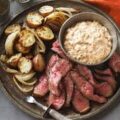“Some Texans at a chili cookoff will make chili from any type of meat that isn’t obvious poison,” observed Texas food experts Phil Brittin and Joseph Daniel. “Riding high atop the whims of culinary inspiration, they will cook with wild boar, bear, rattlesnake, raccoon, armadillo, and nutria.” Other animal meats
that appear in chili are porcupine, javelina, jackrabbit, shrimp, and squirrel. Hunters believe that venison makes the best chili— or elk, or even moose—and restaurant chefs love pork or veal. It strikes us as odd that chicken chili is rarely mentioned.

Granted, there’s no law prohibiting the use of such meat-bearing critters, but most competition cooks stick to beef. “The generally accepted came is beef, mature beef,” wrote Joe Cooper in With or Without Beans in 1952. After all, considering the possible origin of chili along cattle drives, it would be downright disloyal to put lamb or goat meat in chili. Given that the ideal meat in chili defaults to beef, the debate really begins to heat up.
Your Cut, Senor
There is a chili axiom that holds: Only Use the Poorest Cuts of Beef for Chili. One of the first chilliheads to formulate that axiom was Joe Cooper, who wrote, “It is not ever desirable, much less necessary, to buy expensive cuts of prime or choice beef for a pot of chili.” The reasoning was that because of its long cooking time, chili needed meats that have worked the hardest on the steer and are therefore the toughest and least fatty: the neck, rump, and legs. Beef stew meat is composed of such cuts.
Cooper proclaimed that “the best came is bull neck— normally the least desirable meat in the carcass of an animal which best should be three to five or six years old.” Since such a cut was hard to find, he relented and suggested any chuck shoulder cut.
Bill Bridges reported in The Great American Chili Book that Merle Ellis, the syndicated butcher, recommended the center section of the beef shank. “With long, slow simmering, like a pot of chili gets,” Ellis wrote in his column on chili, “the connective tissue in beef shank virtually dissolves and makes a rich, beefy pot liquor that is the very essence of a good pot of chili.”
Floyd Cogan noted that cows and steers always lie down on the same side, and that the “beefy side” of a cow or steer is the side they don’t lie down on. He suggested taking note of which side the steer lies on, and then selecting the other side for chili meat— a suggestion that our city-dwelling chili cooks will find a bit difficult to utilize.
Our chili chemist, Dr. John K. Crum, wrote in his paper, “A Small Dissertation Upon Chili con Carne,” that a “good quality round steak” makes the best chili. Other steaks that commonly appear in chilis are chuck, flank, and even sirloin. John Thorne suggested brisket, which is certain to bring protests from the barbecue crowd. Andy Housholder, author of How to Make a Championship Chili and Win!, insists that London broil is the cut of choice.
Whichever cut you select, Floyd Cogan suggests one with a little more fat than usually appears in round steak. Joe Cooper disagrees, suggesting lean meat, and wrote that the “fat will be added under its own entity.” But more on fat later.
Battle of the Meats: Ground vs. Cubed
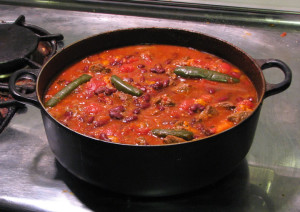
Finally, there is some minor agreement on one point in chili making: that hamburger meat makes lousy chili. John Thorne observed: “Ordinary ground meat turns to mush when subjected to long cooking. It also reminds some cooks of spaghetti sauce, with disastrous results . . . one-half inch cubes are the established norm.”
Many chili cooks these days believe that only a stainless steel knife should be use to cut the cubes that size. Some purists disdain knives and prefer scissors because their cut supposedly retains the juiciness and flavor of the meat. Considering the fact that the meat breaks down during cooking no matter what
cuts it, the fallacy of using scissors is obvious.
R. F. Carlisle analyzed that two sizes of cut meat were optimal: “Small pieces should be in the range of the size of a lima bean, large pieces in the range of the size of a purple grape.” His theory held that in this combination, “the raw meat should have a coarser characteristic than desired in the final chili.”
Andy Housholder, who won fourteen out of eighteen chili cookoffs in eight years, wrote that cubed meats win 95 percent of chili competitions. Abilene chili expert Sam Pendergrast vehemently disagreed with the
cubed-meat concept. “The second and perhaps penultimate disaster for Texas Chili,” he wrote in Chile Pepper magazine, “is the “Cubed Steak with Brown Gravy Syndrome” (CSWBG), and it probably started— as many bad things do for Texas— around Houston. I think the CSWBG movement might have evolved through a scenario rather like this: probably under the mistaken truism that more expensive is automatically better in all things, somebody started buying high-grade steak and carefully hand-slicing it into tiny, uniform, fat-free cubes, then sauteeing them into a rich gravy without too much of those old Mexican spices that have given chili such a good (or bad) name over the years. Eventually the cubed steak won a chili contest—probably sooner than later if the cook happened to be a judge. Eventually, lots of cooks started making the cubed steak ‘chili,’ and as more of it was made, more of it was likely to win contests— particularly since a preliminary judge who had cubed his steak might have an advantage in recognizing his own recipe.”
Sam, of course, preferred his meat in the classic “chili grind” method, whereby butchers used three-eighths-inch or half-inch holes in the blades of the meat grinder. Chili grind is often not available in supermarkets, but it can be replicated by using an electric meat grinder with a coarse blade. The purpose of cutting or grinding the meat is to, in effect, render it into smaller morsels that become tender more easily than larger pieces. “Tenderizing can also be effected chemically by using commercial products that contain papain or other enzymes that digest protein in muscles and connective tissue,” suggested Dr. Crum. The chili meat of any cut or grind can be tenderized by marinating it in papaya juice or commercial tenderizing powder.
Meat tenderized in such a fashion will not require the lengthy cooking time. And with all due respect to championship chilis, we should point out that withquick chilis, made for lunch from commercial mixes in about an hour, hamburger meat works fine.
The Grease and the Browning
“Why is the meat not merely cut or ground and dumped into boiling water to cook?” posited Dr. Crum. He then went on to answer his own question: “The reason is that browning imparts a better flavor to the meat because of some interesting chemistry! Frying (or sauteing) with just enough fat or oil to prevent sticking at a relatively high temperature causes the meat to brown— in very simple terms, the proteins at the surface of the meat are converted to other proteins that result in a more intense flavor.” And to achieve such a high temperature, Dr. Crum recommended using avocado oil, with its extremely high smoke point of 600°F. Such intense heat, according to food chemistry expert Harold McGee, triggers “browning reactions, exceedingly complex chemical changes that involve mostly proteins and carbohydrates.”
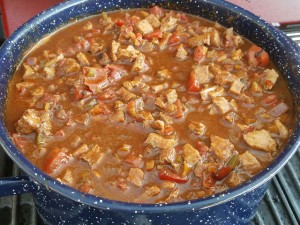
Everyone knows that the crusty, browned portions of roasted and fried meats are more intensely flavored than the rest of the cut being cooked. The reason for this is that the interior of meats cannot be heated beyond the boiling point of water until all the water is removed— at which point the meat would be very tough. However, the outside of the meat can be extremely hot because moisture is being drawn from inside the meat. The extremely hot temperature accelerates the browning reaction, giving the meat much more flavor. It should be noted that Dr. Crum called for browning the meat thoroughly, whereas many of the early chili recipes recommended browning the meat just “until gray.” It makes sense that chili meat that is more thoroughly browned will have more flavor than meat that is just gray.
There are quite a number of oils and fats used by chili cooks to brown the meat. The old-timers generally used beef suet, which is the fat that surrounds the kidneys. (Tallow is the fat around the muscles.)
Butchers can still provide suet, which should be fresh and then ground or chopped. It is usually rendered before the meat is browned in it, but some cooks add the meat and suet together and leave the pieces of browned suet (cracklings) in their chili.
One drawback to suet is that it is saturated fat and thus highly disreputable in this day and age. However, most of the fat can be removed later. Two other old-fashioned meat-browning agents are bacon fat and salt pork, which purists insist impart a unique flavor to the chili.
These days, vegetable oils are commonly used to brown the meat, with corn oil being the most popular. Interestingly enough, olive oil crops up often in some of the early recipes, including those from turn-of the-century California. Safflower oil and peanut oil are also popular, as are margarine and butter. Before moving on, we should point out that some chili cooks brown the meat not by sauteing it in fat but by grilling the meat over wood or charcoal before it is ground or chopped for the pot.
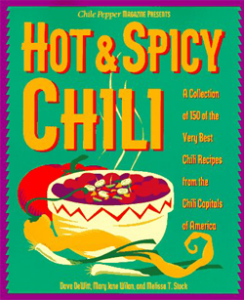
Latest posts by Mark Masker (see all)
- 2024 Scovie Awards Call for Entries - 07/07/2023
- 2024 Scovie Awards Early Bird Special: 3 Days Left - 06/29/2023
- 2024 Scovie Awards Early Bird Deadline Looms - 06/25/2023

